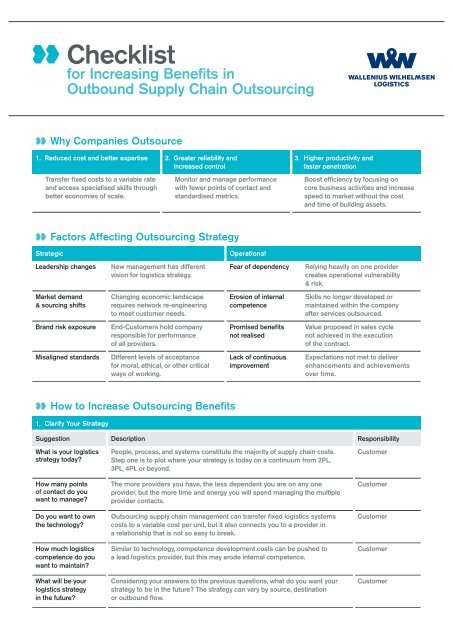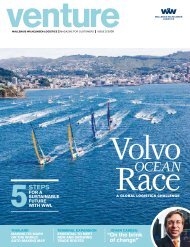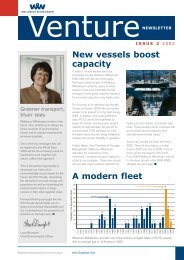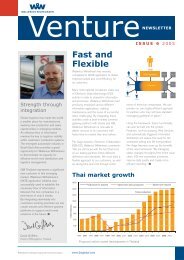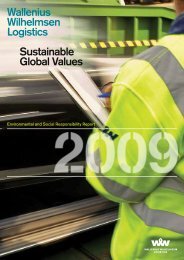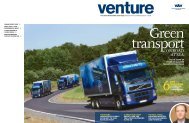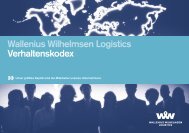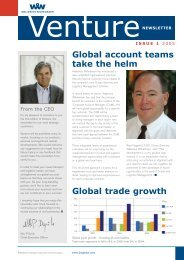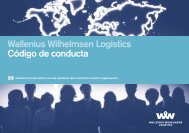Outsourcing Risk Checklist - Wallenius Wilhelmsen Logistics
Outsourcing Risk Checklist - Wallenius Wilhelmsen Logistics
Outsourcing Risk Checklist - Wallenius Wilhelmsen Logistics
Create successful ePaper yourself
Turn your PDF publications into a flip-book with our unique Google optimized e-Paper software.
Strategic Operational<br />
Leadership changes New management has different<br />
vision for logistics strategy.<br />
Market demand<br />
& sourcing shifts<br />
Changing economic landscape<br />
requires network re-engineering<br />
to meet customer needs.<br />
Brand risk exposure End-Customers hold company<br />
respon sible for performance<br />
of all providers.<br />
Misaligned standards Different levels of acceptance<br />
for moral, ethical, or other critical<br />
ways of working.<br />
1. Clarify Your Strategy<br />
Fear of dependency Relying heavily on one provider<br />
creates operational vulnerability<br />
& risk.<br />
Erosion of internal<br />
competence<br />
Promised benefits<br />
not realised<br />
Lack of continuous<br />
improvement<br />
Skills no longer developed or<br />
maintained within the company<br />
after services outsourced.<br />
Value proposed in sales cycle<br />
not achieved in the execution<br />
of the contract.<br />
Expectations not met to deliver<br />
enhancements and achievements<br />
over time.<br />
Suggestion Description Responsibility<br />
What is your logistics<br />
strategy today?<br />
How many points<br />
of contact do you<br />
want to manage?<br />
Do you want to own<br />
the technology?<br />
How much logistics<br />
competence do you<br />
want to maintain?<br />
What will be your<br />
logistics strategy<br />
in the future?<br />
<strong>Checklist</strong><br />
for Increasing Benefits in<br />
Outbound Supply Chain <strong>Outsourcing</strong><br />
Why Companies Outsource<br />
1. Reduced cost and better expertise 2. Greater reliability and<br />
increased control<br />
Transfer fixed costs to a variable rate<br />
and access specialised skills through<br />
better economies of scale.<br />
Monitor and manage performance<br />
with fewer points of contact and<br />
standardised metrics.<br />
Factors Affecting <strong>Outsourcing</strong> Strategy<br />
How to Increase <strong>Outsourcing</strong> Benefits<br />
People, process, and systems constitute the majority of supply chain costs.<br />
Step one is to plot where your strategy is today on a continuum from 2PL,<br />
3PL, 4PL or beyond.<br />
The more providers you have, the less dependent you are on any one<br />
provider, but the more time and energy you will spend managing the multiple<br />
provider contacts.<br />
<strong>Outsourcing</strong> supply chain management can transfer fixed logistics systems<br />
costs to a variable cost per unit, but it also connects you to a provider in<br />
a relationship that is not so easy to break.<br />
Similar to technology, competence development costs can be pushed to<br />
a lead logistics provider, but this may erode internal competence.<br />
3. Higher productivity and<br />
faster penetration<br />
Considering your answers to the previous questions, what do you want your<br />
strategy to be in the future? The strategy can vary by source, destination<br />
or outbound flow.<br />
Boost efficiency by focusing on<br />
core business activities and increase<br />
speed to market without the cost<br />
and time of building assets.<br />
Customer<br />
Customer<br />
Customer<br />
Customer<br />
Customer
2. Choose The Right Provider<br />
Suggestion Description Responsibility<br />
Determine provider<br />
relationship type<br />
Determine profile<br />
of provider<br />
Determine payment<br />
structure<br />
Communicate<br />
environmental<br />
requirements<br />
3. Actively Manage The Relationship<br />
Transactional – Usually a short term relationship with no bonding between<br />
you and the provider.<br />
Tactical – Based on a comparatively longer term (normally 1–5 years)<br />
c ontractual relationship. Transaction-oriented but focus on cost reduction<br />
and service improvement.<br />
Strategic – Based on long term (5+ years) cooperation, such as partnership<br />
or joint venture. Common core values and sharing of risks.<br />
Asset or Non-Asset Based – Should the provider own the assets used for<br />
the services or manage other providers?<br />
Global or Regional – How far of a reach should the provider have?<br />
On-Site or Off-Site Personnel – Should the provider be integrated at the<br />
customer location?<br />
Cost Plus – Pass through of all cost elements with a margin.<br />
Management Fee – Cost per unit flat fee charged separately from other<br />
service costs.<br />
Gainsharing – Share risks and rewards based on performance.<br />
Code of Conduct – A broad base of documents relating to corruption, labour,<br />
economics, and environment in which both customer and provider subscribe<br />
to the same principles and ways of working.<br />
Contractual Compliance – Use specific wording in the contract to comply<br />
with regulations and work regulatory risks into the contract.<br />
4-Factor Optimisation – Optimisation model utilizing CO2 emissions along<br />
with time, cost, and quality in the analysis of supply chain performance.<br />
Customer<br />
Customer<br />
Customer<br />
Customer, Provider<br />
Suggestion Description Responsibility<br />
Maintain multi-level<br />
contacts between<br />
organisations<br />
Conduct annual or<br />
semi-annual contract<br />
review meetings<br />
Prepare and send<br />
monthly performance<br />
reports<br />
For more information,<br />
please contact:<br />
To develop a shared view of the state of the contract, maintain multilevel<br />
commercial and operational contacts from analyst to C-Level. Use the<br />
following the generate more tangible feedback:<br />
• 360 Reviews<br />
• SWOT Analysis<br />
Items to cover:<br />
• Company Strategy Alignment<br />
• Performance Review<br />
• <strong>Risk</strong> Assessment<br />
• Operational Challenges/Issues<br />
• New Business/Improvement Opportunities<br />
Information to include:<br />
• KPI/Metric Reporting<br />
• Root Cause Analysis for Exceptions<br />
• Planned Improvements<br />
• Achieved Benefits<br />
• Issues & <strong>Risk</strong>s Update<br />
Nick Bryan<br />
Vice President<br />
Network Development & Supply Chain Management<br />
email: Nick.Bryan@2wglobal.com<br />
mobile: +47 484 06 923<br />
Please also visit us at www.2wglobal.com<br />
© 2011 <strong>Wallenius</strong> <strong>Wilhelmsen</strong> <strong>Logistics</strong><br />
Customer, Provider<br />
Customer, Provider<br />
Provider


